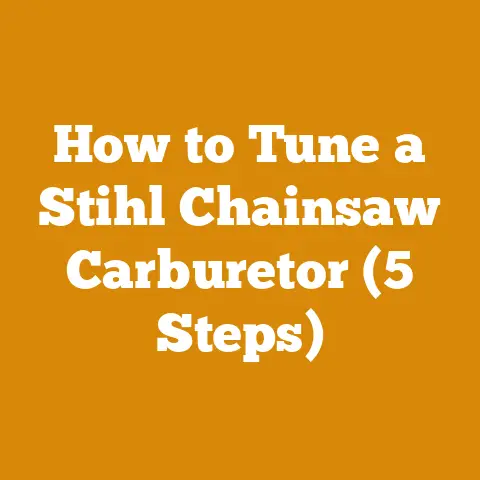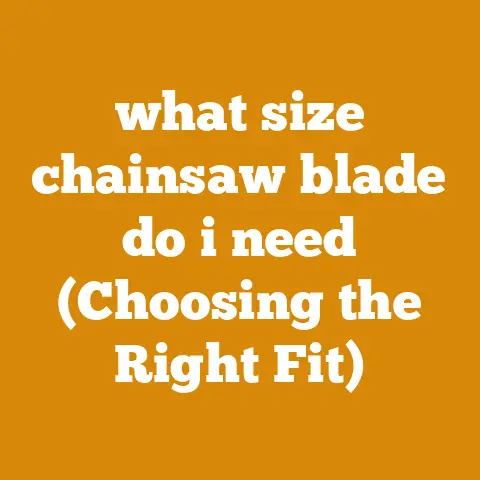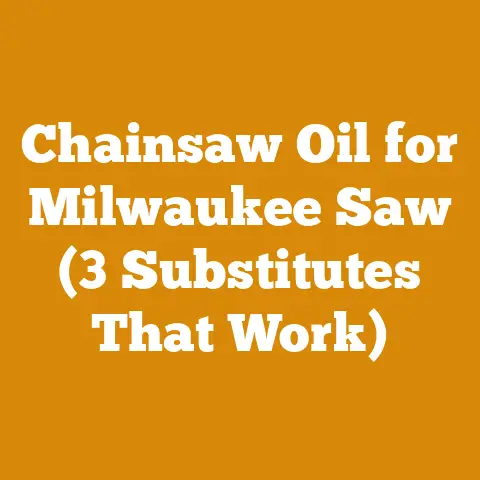How to Remove Echo Chainsaw Clutch (easy Steps)
When I think about smart living, I often reflect on the satisfaction of maintaining my tools, especially my Echo chainsaw. You know, there’s a unique pleasure in knowing that with just a bit of elbow grease, I can keep my chainsaw in top condition without having to call in a professional. Have you ever found yourself halfway through a project when your chainsaw stops working? It’s frustrating, right? But don’t worry—I’ve been there, and I’ve got a step-by-step guide to help you remove your Echo chainsaw clutch like a pro.
Prerequisites and Required Materials
Before we get into the nitty-gritty details and steps, let’s make sure you’re fully prepared. Preparation is key to making any maintenance task smooth and stress-free.
Tools You’ll Need
- Socket Wrench Set: This will be your main tool for loosening and tightening nuts. Make sure the set includes various sizes.
- Flathead Screwdriver: Ideal for prying apart components when necessary.
- Clutch Removal Tool: Specifically designed for Echo chainsaws, this tool will help you remove the clutch without damaging it.
- Pliers: Useful for gripping and pulling small parts or wires.
- Rag or Cloth: To clean components as you go along.
- Protective Gear: Safety goggles and gloves are essential for protection.
Prerequisite Knowledge
It’s helpful to have a basic understanding of chainsaw mechanics. Knowing the components you’re dealing with will make the process less daunting. Familiarity with safety protocols is also crucial to prevent accidents.
Safety First!
I can’t stress enough how important safety is when working on your chainsaw.
- Wear Protective Gear: Always wear safety goggles and gloves to protect your eyes and hands.
- Ensure the Chainsaw is Cool: Never attempt maintenance on a hot chainsaw. Let it cool down completely first.
- Disconnect the Spark Plug: This is a critical step to prevent accidental starts, which can be dangerous.
My Chainsaw Story
Let me share a little story about my first experience with removing a chainsaw clutch. I was deep in the woods, working on clearing some fallen trees after a storm. My Echo chainsaw had been my trusty companion for years, never letting me down. But suddenly, it stopped cold. I was in the middle of nowhere, miles from the nearest repair shop. Panic set in for a moment, but then I remembered what my grandfather used to say: “The best mechanic is the one who learns on the job.”
With some patience and the right tools that I always carry in my truck, I managed to remove the clutch, diagnose the issue, and get everything back in order. That day taught me that sometimes self-reliance and a bit of knowledge can save your day.
Step-by-Step Guide to Removing the Echo Chainsaw Clutch
Let’s get down to business with this detailed guide. Remember, I’m here to guide you through every step as if we’re working side by side.
Step 1: Disconnect the Spark Plug
Safety first! This step ensures that the chainsaw won’t accidentally start during maintenance.
- Locate the Spark Plug Cap: Typically, you’ll find it on top of the engine. It’s usually rubbery and easy to spot.
- Use Pliers: Gently grip the cap with pliers and pull it off without yanking too hard. This disconnection prevents accidental ignition.
Safety Tip: Always double-check that it’s fully disconnected before proceeding.
Step 2: Remove the Chain Brake Assembly
Removing this assembly will give you clear access to the clutch area.
- Release the Chain Tension: Use your flathead screwdriver to turn the tensioner screw until the chain loosens sufficiently.
- Unscrew the Nuts: With your socket wrench, remove all nuts securing the chain brake assembly.
- Lift Off Carefully: Once unscrewed, gently lift off the assembly and set it aside in a safe place.
Tip: Place all screws and nuts in a small container so you don’t lose them.
Step 3: Access the Clutch
Now that you’ve cleared some space, it’s time to get to the heart of the matter.
- Identify the Clutch Cover: This is usually a metal component that protects the clutch mechanism.
- Remove the Clutch Cover: Use your socket wrench again to carefully unscrew and remove this cover.
Step 4: Remove the Clutch
This step requires finesse and the right tool—your clutch removal tool.
- Secure the Piston: Insert a piece of thick rope into the spark plug hole to prevent the piston from moving when you turn the clutch.
- Use the Clutch Removal Tool: Fit this tool onto the clutch nut securely.
- Turn Counterclockwise: Remember, clutches are reverse-threaded on chainsaws, so you’ll turn counterclockwise to loosen it.
Warning: Never force it if it’s not coming off easily; check if everything is properly aligned first.
Step 5: Clean and Inspect
With the clutch now removed, take advantage of this opportunity to ensure everything is in good condition.
- Use a Rag: Wipe down all components thoroughly to remove any dust or debris.
- Check for Wear and Tear: Inspect each part for signs of damage or excessive wear that might indicate replacement is needed.
Step 6: Reassemble
After cleaning and inspection, it’s time to put everything back together.
- Reattach the Clutch: Follow removal steps in reverse order.
- Replace Clutch Cover and Chain Brake Assembly: Secure them tightly using your socket wrench.
- Reconnect Spark Plug: Once everything’s secure, reconnect your spark plug cap firmly.
Tips and Warnings
Helpful Tips
- Label Parts as You Go: Use small pieces of tape or sticky notes to label parts as you remove them.
- Take Photos: A quick photo before disassembly can serve as a helpful reference during reassembly.
- Work in a Clean Area: A tidy workspace helps prevent losing small parts or mixing them up.
Warnings
- Avoid Using Excessive Force: If any part doesn’t come off easily, assess whether you’re doing something wrong before applying more force.
- Ensure All Parts are Tightened Properly: Loose parts can lead to malfunction or accidents during operation.
Common Questions and Troubleshooting
Why is my clutch stuck?
A stuck clutch could be due to dirt buildup or rust, especially if your chainsaw hasn’t been used for a while. Apply a bit of penetrating oil around the edges of the clutch and let it sit for about 15 minutes before attempting removal again.
Can I use regular tools instead of a clutch removal tool?
While it’s possible to use other tools, it’s not recommended. A specialized clutch removal tool is designed to fit perfectly without damaging any components. Investing in one is worth it for both safety and effectiveness.
What if I can’t get the chain brake assembly off?
If you’re struggling with this step, double-check that you’ve released all chain tension and removed every necessary nut or bolt. Sometimes applying gentle pressure while wiggling can help loosen stubborn parts.
Regular Maintenance Practices
- Clean Your Chainsaw After Every Use: Debris can accumulate quickly, affecting performance over time.
- Sharpen Your Chain Regularly: A sharp chain cuts more efficiently and puts less strain on both you and the machine.
- Check Oil Levels Frequently: Proper lubrication is critical for all moving parts within your chainsaw.
My Personal Routine
I like to set aside time at least once every month solely dedicated to maintaining my tools. It’s become a peaceful ritual where I not only ensure everything’s running smoothly but also reconnect with what I enjoy—working with my hands outdoors.
Conclusion and Next Steps
Congratulations! You’ve successfully navigated through removing and inspecting an Echo chainsaw clutch. The skills you’ve learned here will not only help keep your equipment in top-notch condition but also empower you with self-reliance—a valuable trait in any toolkit.
Remember these steps next time you’re faced with a similar situation or share them with someone who might need guidance themselves! Keep practicing these maintenance skills regularly; they’ll serve you well now and into future projects too!
FAQ Section
How often should I check my chainsaw clutch?
It’s advisable regularly checking every few months or after particularly heavy use sessions ensures any potential issues are caught early on before becoming major problems!
Is it normal for clutches wear out?
Yes! Over time due friction usage clutches naturally experience wear tear requiring eventual replacement keep things running smoothly safely possible long term basis!
Should I replace repair damaged clutch?
If significant damage present visible signs excessive wear replacement usually best option maintaining optimal functionality safety standards going forward!






